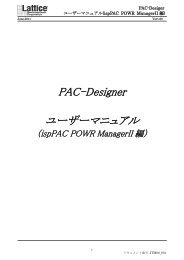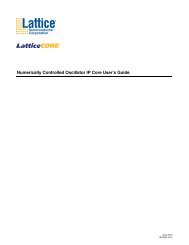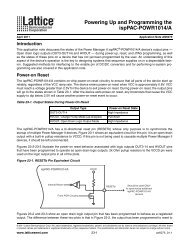Lattice ispMACH 4000 ZC/ZE Product Family Qualification Summary
Lattice ispMACH 4000 ZC/ZE Product Family Qualification Summary
Lattice ispMACH 4000 ZC/ZE Product Family Qualification Summary
You also want an ePaper? Increase the reach of your titles
YUMPU automatically turns print PDFs into web optimized ePapers that Google loves.
2.0 LATTICE PRODUCT QUALIFICATION PROGRAM<br />
<strong>Lattice</strong> Semiconductor Corp. maintains a comprehensive reliability qualification program to assure that each<br />
product achieves its reliability goals. After initial qualification, the continued high reliability of <strong>Lattice</strong> products is<br />
assured through ongoing monitor programs as described in Reliability Monitor Program Procedure (Doc. #70-<br />
101667). All product qualification plans are generated in conformance with <strong>Lattice</strong> Semiconductor’s <strong>Qualification</strong><br />
Procedure (Doc. #70-100164) with failure analysis performed in conformance with <strong>Lattice</strong> Semiconductor’s Failure<br />
Analysis Procedure (Doc. #70-100166). Both documents are referenced in <strong>Lattice</strong> Semiconductor’s Quality<br />
Assurance Manual, which can be obtained upon request from a <strong>Lattice</strong> Semiconductor sales office. Figure 2.1<br />
shows the <strong>Product</strong> <strong>Qualification</strong> Process Flow.<br />
If failures occur during qualification, an 8 Discipline (8D) process is used to find root cause and eliminate the failure<br />
mode from the design, materials, or process. The effectiveness of any fix or change is validated through additional<br />
testing as required. Final testing results are reported in the qualification reports.<br />
Failure rates in this reliability report are expressed in FITS. Due to the very low failure rate of integrated circuits, it<br />
is convenient to refer to failures in a population during a period of 10 9 device hours; one failure in 10 9 device hours<br />
is defined as one FIT.<br />
<strong>Product</strong> families are qualified based upon the requirements outlined in Tables 2.2. In general, <strong>Lattice</strong><br />
Semiconductor follows the current Joint Electron Device Engineering Council (JEDEC) and Military Standard<br />
testing methods. <strong>Lattice</strong> automotive products are qualified and characterized to the Automotive Electronics Council<br />
(AEC) testing requirements and methods. <strong>Product</strong> family qualification will include products with a wide range of<br />
circuit densities, package types, and package lead counts. Major changes to products, processes, or vendors<br />
require additional qualification before implementation.<br />
The <strong>ispMACH</strong> <strong>4000</strong><strong>ZC</strong>/<strong>ZE</strong> and LA-<strong>ispMACH</strong> <strong>4000</strong><strong>ZC</strong> product families are built on <strong>Lattice</strong> Semiconductor’s 1.8V<br />
EE9 process. EE9 is a shallow trench isolated 0.18um Leff CMOS process with Electrically Erasable cell (E 2 cell)<br />
modules. This process uses five, planarized metal interconnect layers and single layer polysilicon.<br />
<strong>Lattice</strong> Semiconductor maintains a regular reliability monitor program. The current <strong>Lattice</strong> Reliability Monitor Report<br />
can be found at www.latticesemi.com/lit/docs/qa/product_reliability_monitor.pdf .<br />
INDEX Return<br />
6










